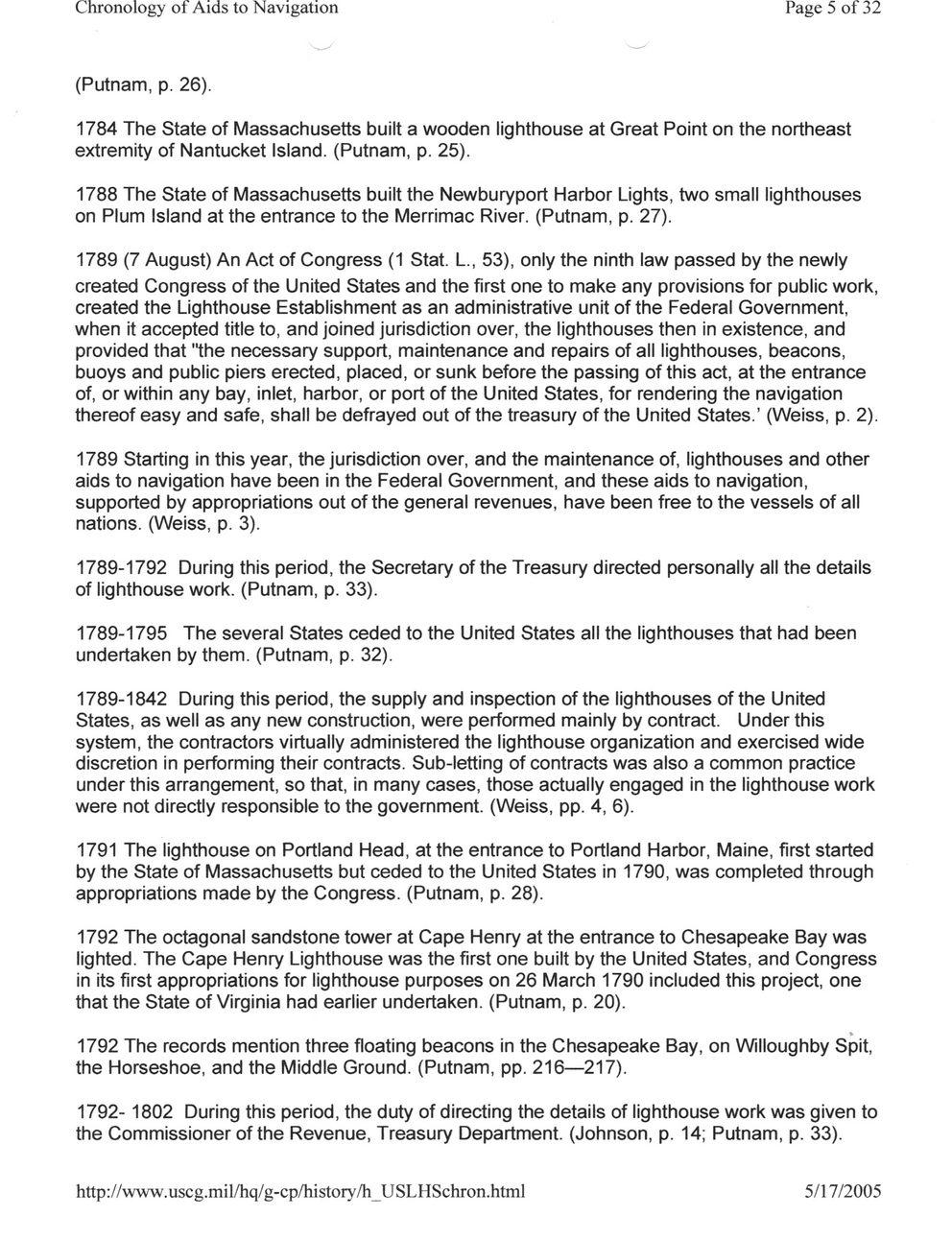This text was obtained via automated optical character recognition.
It has not been edited and may therefore contain several errors.
Chronology of Aids to Navigation Page 5 of 32 (Putnam, p. 26). 1784 The State of Massachusetts built a wooden lighthouse at Great Point on the northeast extremity of Nantucket Island. (Putnam, p. 25). 1788 The State of Massachusetts built the Newburyport Harbor Lights, two small lighthouses on Plum Island at the entrance to the Merrimac River. (Putnam, p. 27). 1789 (7 August) An Act of Congress (1 Stat. L., 53), only the ninth law passed by the newly created Congress of the United States and the first one to make any provisions for public work, created the Lighthouse Establishment as an administrative unit of the Federal Government, when it accepted title to, and joined jurisdiction over, the lighthouses then in existence, and provided that "the necessary support, maintenance and repairs of all lighthouses, beacons, buoys and public piers erected, placed, or sunk before the passing of this act, at the entrance of, or within any bay, inlet, harbor, or port of the United States, for rendering the navigation thereof easy and safe, shall be defrayed out of the treasury of the United States.’ (Weiss, p. 2). 1789 Starting in this year, the jurisdiction over, and the maintenance of, lighthouses and other aids to navigation have been in the Federal Government, and these aids to navigation, supported by appropriations out of the general revenues, have been free to the vessels of all nations. (Weiss, p. 3). 1789-1792 During this period, the Secretary of the Treasury directed personally all the details of lighthouse work. (Putnam, p. 33). 1789-1795 The several States ceded to the United States all the lighthouses that had been undertaken by them. (Putnam, p. 32). 1789-1842 During this period, the supply and inspection of the lighthouses of the United States, as well as any new construction, were performed mainly by contract. Under this system, the contractors virtually administered the lighthouse organization and exercised wide discretion in performing their contracts. Sub-letting of contracts was also a common practice under this arrangement, so that, in many cases, those actually engaged in the lighthouse work were not directly responsible to the government. (Weiss, pp. 4, 6). 1791 The lighthouse on Portland Head, at the entrance to Portland Harbor, Maine, first started by the State of Massachusetts but ceded to the United States in 1790, was completed through appropriations made by the Congress. (Putnam, p. 28). 1792 The octagonal sandstone tower at Cape Henry at the entrance to Chesapeake Bay was lighted. The Cape Henry Lighthouse was the first one built by the United States, and Congress in its first appropriations for lighthouse purposes on 26 March 1790 included this project, one that the State of Virginia had earlier undertaken. (Putnam, p. 20). 1792 The records mention three floating beacons in the Chesapeake Bay, on Willoughby Spit, the Horseshoe, and the Middle Ground. (Putnam, pp. 216—217). 1792- 1802 During this period, the duty of directing the details of lighthouse work was given to the Commissioner of the Revenue, Treasury Department. (Johnson, p. 14; Putnam, p. 33). http://www.uscg.mil/hq/g-cp/history/h_USLHSchron.html 5/17/2005

Lighthouses Chronology-of-Aids-to-Navigation-(05)